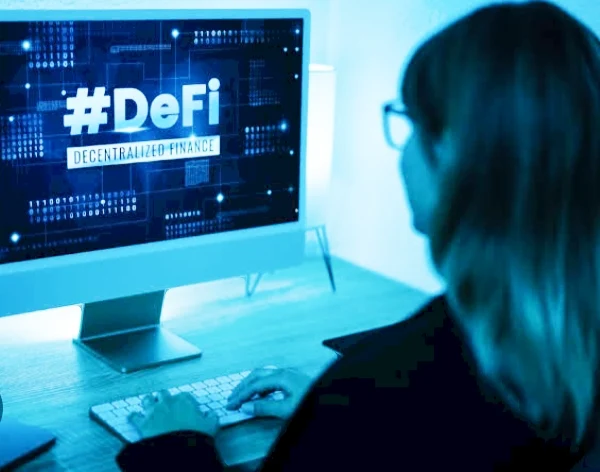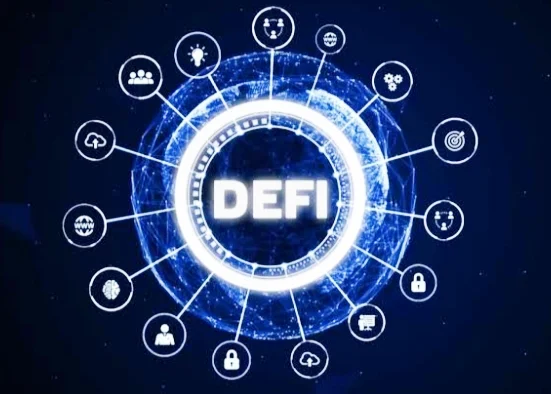Collaboration Between Traditional Institutions and DeFi: Shaping the Future of Finance
The initial perception of Decentralized Finance (DeFi) as a threat to traditional institutions is rapidly transforming into a vision of collaboration. DeFi's innovative technology and established institutions' experience and reach hold immense potential to revolutionize the financial landscape.
Why Collaboration Makes Sense
Both DeFi and traditional institutions have limitations that collaboration can address:
- DeFi: While efficient and transparent, DeFi can be complex and lack regulatory clarity.
- Traditional Institutions: They offer security and compliance but may struggle with innovation and efficiency.
By working together, they can leverage each other's strengths:
- DeFi's Automation: Streamlines processes and reduces costs.
- Traditional Institutions' Expertise: Provides regulatory compliance and user-friendly interfaces.
The Future Through Collaboration
Here are some specific examples of how collaboration can unlock exciting possibilities:
| Collaboration Project | Description | Benefits |
|---|---|---|
| Trade Finance on Blockchain | Banks and DeFi platforms join forces to automate trade finance processes. Smart contracts handle loan approvals, collateral management, and escrow services. | Faster settlements, lower administrative costs, and enhanced transparency for all parties involved. |
| Security Token Offerings (STOs) for SMEs | Investment banks and DeFi platforms collaborate to enable small and medium-sized enterprises (SMEs) to raise capital through compliant Security Token Offerings (STOs). | Increased access to capital for SMEs, efficient token issuance/trading, and improved liquidity. |
| Microinsurance on DeFi | Traditional insurance companies partner with DeFi platforms to offer microinsurance products with automated claims processing via smart contracts. | Makes microinsurance products viable for insurers by reducing administrative costs and provides vital coverage to underserved populations. |
| Sustainable DeFi Investments | Asset managers and DeFi platforms co-create DeFi-based funds that invest in projects focused on environmental or social impact. | Transparent and trackable investment vehicles cater to environmentally or socially conscious investors, promoting sustainable development. |
A New Era of Financial Services
These are just a few examples, and the possibilities for collaboration are vast. As DeFi continues to evolve, we can expect to see even more innovative projects emerge, driven by the combined efforts of traditional institutions and the DeFi ecosystem. This collaboration has the potential to create a future of financial services that is more efficient, transparent, inclusive, and accessible to all.
Real-World Collaboration Between DeFi and Traditional Institutions
While the future holds immense promise for DeFi and traditional institution collaboration, several exciting projects are already underway:
-
Sygnum Bank (Switzerland) & DeFi Pulse Index: Sygnum, a Swiss digital asset bank, partnered with DeFi Pulse to launch the world's first regulated DeFi index fund. This fund tracks the performance of a basket of DeFi tokens, allowing investors to gain exposure to the DeFi market through a secure and compliant product.
-
Aave (DeFi Lending Protocol) & Aave Arc: Aave, a leading DeFi lending protocol, launched Aave Arc, a permissioned liquidity market specifically designed for institutional investors. Aave Arc provides institutions with a secure and regulated environment to access DeFi lending and borrowing services, addressing their regulatory concerns.
-
MakerDAO (DeFi Stablecoin Protocol) & Visa: MakerDAO, the issuer of the DAI stablecoin, collaborated with Visa to enable merchants to settle transactions using DAI. This collaboration aims to bridge the gap between traditional finance and DeFi, offering merchants faster settlements and potentially lower fees.
-
World Bank & The Sandbox (Metaverse Platform): The World Bank partnered with The Sandbox, a metaverse platform built on the Ethereum blockchain, to create a "Financing the Future of the Internet" world. This initiative aims to educate users about decentralized finance concepts and explore potential applications like innovative social impact financing within the metaverse.
These real-world projects showcase the power of collaboration between DeFi and traditional institutions. They demonstrate the potential for increased accessibility, regulatory compliance, and innovative financial products for a broader audience. As the industry continues to evolve, we can expect to see even more groundbreaking projects emerge from this exciting partnership.
Real-World Collaboration Between DeFi and Traditional Institutions
The initial perception of Decentralized Finance (DeFi) as a threat to traditional institutions is rapidly transforming into a vision of collaboration. DeFi's innovative technology and established institutions' experience and reach hold immense potential to revolutionize the financial landscape.
Actual DeFi Projects Highlighting Collaboration
| Project | Description | Benefits |
|---|---|---|
| Sygnum Bank (Switzerland) & DeFi Pulse Index | Swiss digital asset bank Sygnum launches the world's first regulated DeFi index fund, allowing investors exposure to DeFi through a secure product. | Increased accessibility to DeFi for traditional investors. |
| Aave (DeFi Lending Protocol) & Aave Arc | Leading DeFi lending protocol Aave launches Aave Arc, a permissioned liquidity market for institutions. | Institutions gain access to secure and regulated DeFi lending and borrowing. |
| MakerDAO (DeFi Stablecoin Protocol) & Visa | MakerDAO collaborates with Visa to enable merchants to settle transactions using the DAI stablecoin. | Bridges the gap between DeFi and traditional finance, offering merchants faster settlements and potentially lower fees. |
| World Bank & The Sandbox (Metaverse Platform) | World Bank partners with The Sandbox to create an educational world within the metaverse focused on DeFi concepts. | Increased awareness and exploration of DeFi's potential for innovative social impact financing. |
Conclusion
These real-world projects showcase the power of collaboration between DeFi and traditional institutions. They demonstrate the potential for:
- Increased Accessibility: DeFi becomes more accessible to a broader audience through traditional institutions' reach and user-friendly interfaces.
- Regulatory Compliance: Collaboration helps navigate regulatory hurdles and create compliant DeFi products, fostering trust and wider adoption.
- Innovative Financial Products: The combined expertise fosters the development of groundbreaking financial products that leverage the strengths of both DeFi and traditional finance.
As the industry continues to evolve, we can expect even more groundbreaking projects to emerge from this exciting partnership. This collaboration has the potential to create a future of financial services that is more efficient, transparent, inclusive, and accessible to all.
Frequent Asked Questions (FAQs) on Collaboration Between Traditional Institutions and DeFi
1. Why is there growing collaboration between traditional financial institutions and DeFi platforms?
- Innovation: DeFi offers innovative financial products and services that can disrupt traditional markets.
- Efficiency: DeFi can streamline processes and reduce costs for traditional financial institutions.
- Customer Demand: Many customers are increasingly interested in decentralized financial services.
- Competitive Advantage: Embracing DeFi can give traditional institutions a competitive edge.
2. What are the key challenges in such collaborations?
- Regulatory Uncertainty: The regulatory landscape for DeFi is still evolving, creating uncertainty for traditional institutions.
- Technical Complexity: Integrating DeFi technologies into existing systems can be technically challenging.
- Cultural Differences: Traditional institutions and DeFi startups often have different cultures and approaches to business.
- Security Concerns: DeFi platforms face security risks, which traditional institutions must address.
3. What are the potential benefits for both traditional institutions and DeFi platforms from such collaborations?
- Increased Efficiency: DeFi can streamline processes and reduce costs for traditional financial institutions.
- New Revenue Streams: DeFi can create new revenue opportunities for both traditional institutions and DeFi platforms.
- Enhanced Customer Experience: DeFi can offer customers new and innovative financial products.
- Risk Management: DeFi can be used for risk management purposes, such as hedging.
- Market Expansion: DeFi can help traditional institutions expand their reach and serve new customer segments.
4. What are some successful examples of collaboration between traditional institutions and DeFi platforms?
- Partnerships: Many traditional financial institutions have partnered with DeFi startups to explore new opportunities.
- Acquisitions: Some institutions have acquired DeFi companies to gain expertise and technology.
- Joint Ventures: Traditional institutions and DeFi platforms have formed joint ventures to develop new products and services.
5. What are the future prospects for collaboration between traditional institutions and DeFi?
The future of collaboration between traditional institutions and DeFi is promising, as the benefits of decentralized finance become more apparent. However, regulatory clarity and technological advancements will be crucial for widespread adoption.
6. How can traditional institutions and DeFi platforms overcome the challenges of collaboration?
- Open Communication: Both parties need to establish open and transparent communication channels.
- Shared Goals: Clearly defined shared goals can help align interests and facilitate collaboration.
- Risk Management: Implementing robust risk management strategies can mitigate potential risks.
- Regulatory Compliance: Ensuring compliance with all relevant regulations is essential.
- Cultural Adaptation: Both parties may need to adapt to each other's cultures and work styles.
7. What are the potential risks associated with such collaborations?
- Reputation Damage: If a DeFi project fails or is exploited, it could damage the reputation of the traditional institution.
- Regulatory Challenges: Non-compliance with regulations can lead to fines and penalties.
- Technological Risks: The technical complexity of DeFi can introduce risks.
- Competitive Threats: Other institutions may be able to leverage DeFi more effectively.
29 Terms Related to Collaboration Between Traditional Institutions and DeFi
| Term | Definition |
|---|---|
| Decentralized Finance (DeFi) | A financial system that operates on a blockchain network. |
| Traditional Financial Institutions | Banks, insurance companies, and other established financial intermediaries. |
| Innovation | The introduction of new ideas, methods, or products. |
| Efficiency | The ability to achieve a desired outcome with minimal effort. |
| Customer Demand | The desire or need of customers for a particular product or service. |
| Competitive Advantage | A superior position in a market that enables a company to outperform its competitors. |
| Regulatory Uncertainty | The lack of clear or consistent regulations. |
| Technical Complexity | The difficulty of understanding or implementing a technology. |
| Cultural Differences | Differences in attitudes, beliefs, or values that can hinder communication or cooperation. |
| Security Concerns | Risks to the security of a system or network. |
| Partnerships | Collaborative agreements between two or more entities. |
| Acquisitions | The purchase of one company by another. |
| Joint Ventures | Business ventures undertaken jointly by two or more companies. |
| Revenue Streams | Sources of income for a business. |
| Enhanced Customer Experience | Improved satisfaction and loyalty among customers. |
| Risk Management | The process of identifying, assessing, and mitigating risks. |
| Reputation Damage | Harm to the reputation of a company or individual. |
| Regulatory Challenges | Difficulties in complying with regulations. |
| Technological Risks | Risks associated with the use of technology. |
| Competitive Threats | Risks posed by competitors. |
| Regulatory Clarity | Clear and consistent regulations. |
| Technological Advancements | Improvements in technology. |
| Due Diligence | The process of investigating a business or investment opportunity before making a decision. |
| Compliance | Adherence to rules and regulations. |
| Security Measures | Steps taken to protect against hacking and other threats. |
| Gradual Adoption | The slow and steady introduction of a new product or technology. |
| Integration | The process of combining different systems or components. |
| Synergy | The combined effect of two or more things that is greater than the sum of their individual effects. |
| Disruption | A significant change that challenges the status quo. |
| Interoperability | The ability of different systems to work together seamlessly. |
| Collaboration | Working together to achieve a common goal. |
| Alignment | The state of being in agreement or harmony. |



